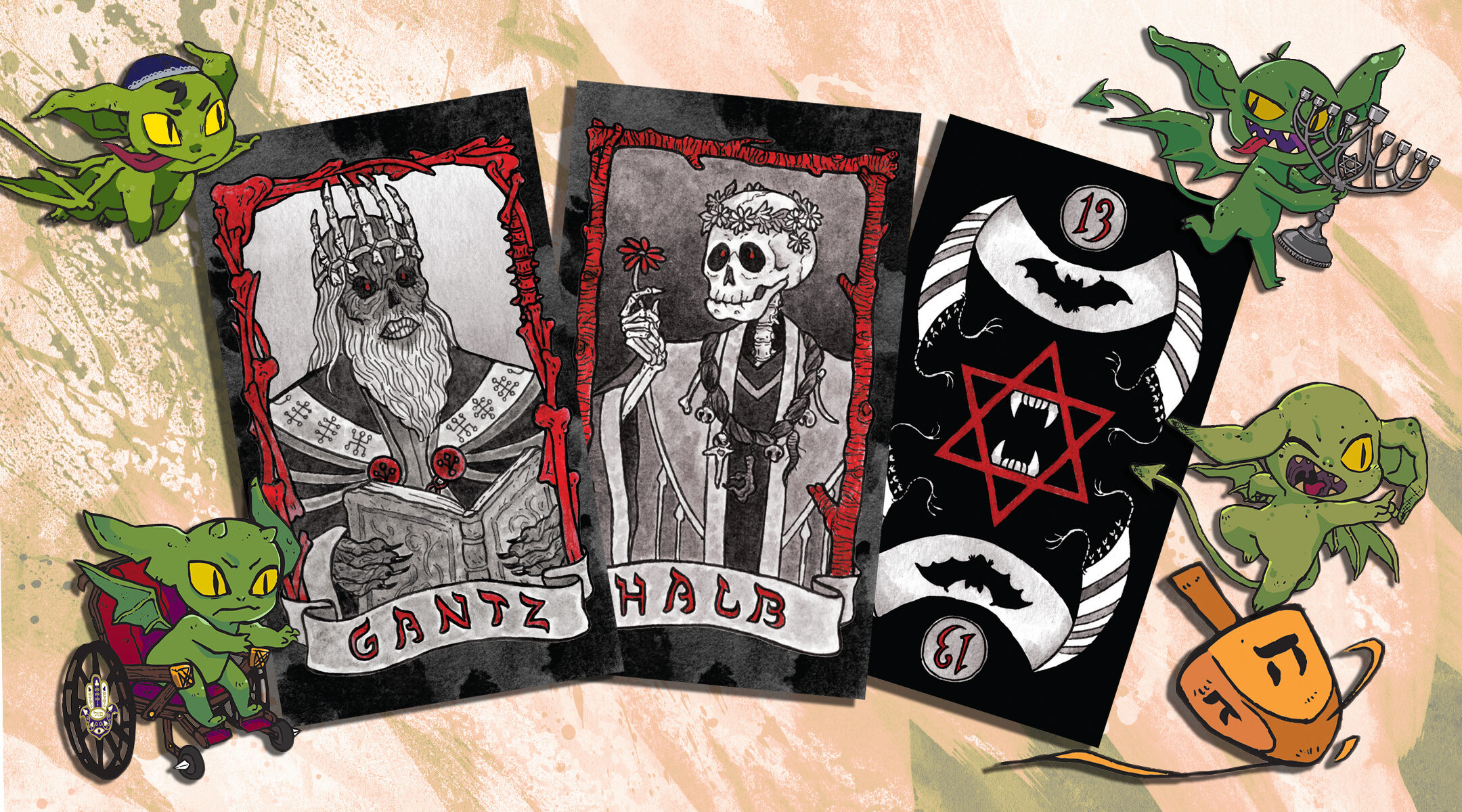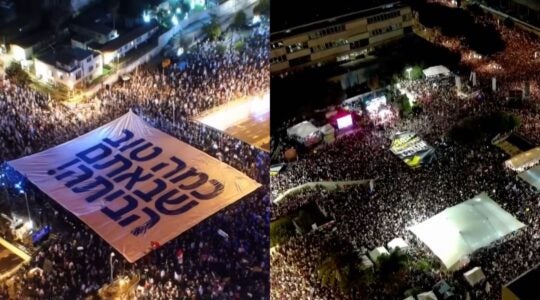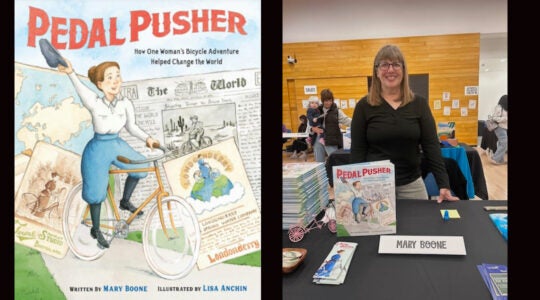(JTA) — Running a not-so-Zagat-rated deli, dropping into a Chinese restaurant for Christmas Eve dinner and acting out a bat mitzvah that involves a vampire — for contemporary board game fans, those can be all in an evening’s play.
That’s because a crop of new games aims to merge Jewish ideas and experiences with the aesthetics and language of games such as Dungeons & Dragons. Dream Apart places players in a fantastical reimagining of a 19th-century shtetl, for example, while J.R. Goldberg’s God of Vengeance draws inspiration from the Yiddish play of the same name. In the games in Doikayt, a collection released in 2020, players can literally wrestle with God.
Known as tabletop role-playing games because they ask players to take on a character, these games and their creators imagine exciting new worlds, subvert classic tropes in fun and irreverent ways, and reinterpret Jewish history and identity.
Tabletop role-playing games like Dungeons & Dragons and Call of Cthulhu have exploded in popularity over the past several years, with many — including at least one group of rabbis — picking up the Zoom-friendly hobby during the height of the COVID-19 pandemic. But the new Jewish games aim to do more than just provide a diversion or even an escape.
“Depending on your family, depending on your synagogue, depending on your community, you may have gotten more or fewer options of what Jewishness could mean in your imagination,” said Lucian Kahn, who created a trilogy of humorous Jewish role-playing games.
“What some of these games are doing is opening that up and pointing to alternate possibilities of imagining Jewishness, not as a way of converting anyone to anything else, but just as a way of showing the tradition is enormous,” he added.
Kahn is the creator of If I Were a Lich, Man, a trilogy of humorous games whose name is a mashup between a “Fiddler on the Roof” song and an undead character, the lich, that frequently appears in fantasy fiction and games. In the title game, players are Jewish liches — spellcasters whose souls, in the lore of Dungeons & Dragons, are stored in phylacteries, the Greek word for tefillin used by Jews in prayer. Representing the four children of the Passover seder, they debate how their community should address the threat of encroaching holy knights.
In some cases, the association of Jews with monsters has given rise to charges of antisemitism — the goblins of “Harry Potter” offer a prime example. But Kahn said he sees Jewish-coded monsters, and queer-coded villains, as figures of resistance.
“There’s a long tradition of looking at the monster and seeing that the reason why these are monsters is because the people who have oppressive power have decided that these are going to be the enemies of the ‘good’ oppressive powers,” Kahn explained. “But if you don’t agree with their ideology, if you’re seeing yourself as being a member of a marginalized community and being in opposition to these oppressive powers, then you can look at the qualities assigned to these monsters and some of them are qualities that are good.”
For Kahn, Jewish-coded monster characters also provide more of an inspiration than the archetypes of more traditional games.
“Maybe somebody thinks they’re insulting me or insulting Jews,” he said. “My response is: I like vampires and liches and trolls and goblins and think they’re much more interesting than bland white muscular humans running through the fields with a cross on their chest hacking at the same things with a sword over and over again.”
Kahn’s outlook has resonated in the tabletop role-playing game community. In February, he and Hit Point Press launched a Kickstarter to fund production of If I Were a Lich, Man. The campaign smashed its $5,000 goal, raising $84,590, enough to hit one of the campaign’s stretch goals of funding a grant to support independent zines about tabletop role-playing games.
The successful campaign means that Kahn’s three games will go into production. In addition to the game about liches, the trilogy includes Same Bat Time, Same Bat Mitzvah, in which players act out a bat mitzvah where one guest has been turned into a vampire, and Grandma’s Drinking Song, inspired by how Kahn’s Jewish great-great grandmother and her children survived in 1920s New York City by working as bootleggers during Prohibition.
In Grandma’s Drinking Song, players write a drinking song together as they act out scenes. Kahn, the former singer/songwriter and guitarist for Brooklyn Jewish queercore folk-punk band Schmekel, wanted to carry over elements of music into this game.
A throughline in all three games is the power of creative resistance to authority — a narrative that Kahn said strikes him as particularly Jewish.
“There are all these stories in Jewish folklore that are really overtly about finding trickster-y or creative ways of fighting back against oppressive and unjust governmental regimes, evil kings, bad advisors,” Kahn said. “One of the first stories I ever heard in my life was the Purim story, so it’s very embedded in my mind as a part of Jewish consciousness, when evil rulers come to power and try to kill us all, we’re supposed to find these outside-the-box ways of preventing that from happening.”
For some Jewish creators, Jewish holidays are an explicit inspiration. Like many Jewish kids of the ‘80s and ‘90s, Max Fefer, a civil engineer by day and game designer by night, grew up loving the picture book “Herschel and the Hanukkah Goblins,” which remains a popular festive text. But as Fefer notes, goblins are often associated with antisemitic stereotypes. Fefer’s first Jewish game, Hanukkah Goblins, turns the story on its head — players interact as the jovial goblins, who are here not to destroy but to spread the spirit of Hanukkah to their goblin neighbors.
Last year, Fefer launched a successful Kickstarter for another Jewish holiday-inspired tabletop role-playing game, Esther and the Queens, where players assume the roles of Esther and her handmaidens from the Purim story, who join together to defeat Haman by infiltrating a masquerade party as queens from a far-off land.
Esther and the Queens channels Fefer’s Purim memories and includes carnival activities, including Skee-Ball; a calm, relaxing Mishloach Manot basket-making; and a fast-paced racing game.
“All of our holidays, they’re opportunities for us to gather as a community in different ways,” Fefer said. “Watching this satirical, comedic retelling of the story of Purim and the Esther Megillah and coming together into a theater, in a synagogue, to watch these spiels and laugh together and spin the graggers when we hear Haman’s name — all of those things help us build identity and community, and I think games in particular surrounding identity, that’s a great way for a Jewish person themselves to feel seen in a game and reinforce their identity, and share their background with friends.”
Another pair of Jewish game creators, Gabrielle Rabinowitz and her cousin, Ben Bisogno, were inspired by Passover.
“The seder is kind of like an RPG in that it’s a structured storytelling experience where everyone takes turns reading and telling, and there’s rituals and things you do at a certain time,” Rabinowitz said. “It’s halfway to an RPG.”
The game became a pandemic project for the two of them, and alongside artist Katrin Dirim and a host of other collaborators, they created Ma Nishtana: Why Is This Night Different? — a story game modeled on their family’s seder. The game follows the main beats of the Exodus story, and in every game, there will be a call to action from God, a moment of resistance, a departure and a final barrier — but different characters and moments resonate depending on the players’ choices.
As an educator at the Museum of Natural History, Rabinowitz said she is often thinking about how to foster participation and confidence, and she wanted to create a game-play mechanic to encourage players to be “as brazen as her family is.” The result was an in-game action called “Wait! Wait! Wait!” — if players wish to ask a question, make a suggestion, disagree with a course of action or share a new perspective, they can call out “Wait! Wait! Wait!” to do so.
The game also includes a series of scenes that are actively roleplayed or narrated, and each includes a ritual — one that can be done in-person or an alternate remote-friendly version. For example, at one point each player must come up with a plague inspired by the new story they’re telling together, and in the remote version, players go camera-off after reciting theirs.
“The fact that it was created during the pandemic and a way for us to connect and other people to connect with each other is really the soul of the game,” Rabinowitz said. “After each person tells a plague, by the end, all the cameras are off and everyone stays silent for another minute. It’s a hugely impactful moment when you’re playing remotely. The design is interwoven in the game itself.”
Rabinowitz said by playing a story of a family undergoing these trials, the themes of family and identity deepen every time she plays the game.
“A lot of people say, ‘Wow, I’ve never felt more connected to this story,’” she said. “Embodying these characters gave me a feeling of relevance and that makes it feel important as a Jewish precept.”
For other creators, that deep connection comes in more lighthearted scenarios. Nora Katz, a theatremaker, game designer and public historian working at the Goldring/Woldenberg Institute of Southern Jewish Life (ISJL) by day, created the Jewish deli-centered game Lunch Rush, which was included in the Doikayt anthology.
“There’s also types of institutions that come up a lot in [tabletop role-playing games], especially sort of high fantasy,” she said. “Everyone meets in a tavern, there’s an inn, things like that. So the idea of a deli as a central gathering place in a world like that felt fun to me.”
An important element of Lunch Rush is that players must be eating while playing, so for Katz’s first round with friends, they got together with chocolate chip ice cream and dill pickle potato chips. She said the deli is a shared language, and her fellow players were all bringing in their own favorite things about delis they loved into the fictional place they were building together.
Tabletop role-playing games “at their core are about collaboration and relationships and storytelling and community, and for me, all of those things are also what Jewishness is about, to me they totally go hand in hand,” Katz said.
The games are not meant to be for Jewish players only. Rabinowitz said the guidebook for Ma Nishtana includes essays to encourage people to further engage with the narrative.
“Jewish players, non-Jewish players, priests, non-religious people, all different people have played it and almost all of them have told us it’s given them a new way of thinking of how they relate to religious tradition, and I didn’t really set out to do that,” Rabinowitz said. “I feel really privileged to have helped create that space.”
Rabinowitz and Bisogno also commissioned other creators to build alternate backdrops for their game, so it can be repurposed to telling the story of another oppressed people’s fight for freedom. Players can interact as embattled yaoguai, spirits from Chinese mythology; explore a Janelle Monáe-inspired Afrofuturist world; play as Indigenous land defenders; or unionize as exploited workers at “E-Shypt.”
Fefer, who has been amplifying the work of other Jewish creators in the tabletop role-playing game space, said the harm of stereotyping and reinforcing negative tropes is still present in the industry, and not just for Jewish people. For example, fans recently criticized Dungeons & Dragons publishers Wizards of the Coast for reinforcing anti-Black stereotypes in the descriptions of a fantasy race, the Hadozee.
“I think it’s a process of talking to people who are from these groups and bringing them onto your teams and making sure you’re incorporating their perspectives into, in the example of Dungeons & Dragons, a hundred-million-dollar industry, being intentional about that design and looking at things from lots of different angles,” Fefer said. “How could our branding, our games be reinforcing something we’re not even aware of?”
Fefer hopes people who play Hanukkah Goblins and Esther and the Queens feel seen and have moments of shared joy, and also that they learn something from these games — about the antisemitic tropes in fantasy, or about underrepresented groups within the Jewish community. With Esther and the Queens, Fefer collaborated with a writer and artist, Noraa Kaplan, to retell the Purim story from a queer and feminist lens, drawing on Jewish texts that the pair said shows the long presence of queer and trans people in Jewish tradition.
“We have a lot of richness within Judaism to share our culture and share our upbringing but also just be representation,” Fefer added. “We’re living in a time of heightened antisemitism and the world being a gross place to be at times, and we can really bring the beauty of Judaism into game design and create experiences for people that are both representative of Judaism and also just very Jewish experiences.”
But for all the important conversations and learning experiences that can come from Jewish tabletop role-playing games, Katz said the goofiness and joy is important, too.
“We live in such a horrendous society that is of our own making,” she said. “If you can, for a little while, enjoy an anticapitalist fictional deli that you and your friends live in, I think that’s great.”
JTA has documented Jewish history in real-time for over a century. Keep our journalism strong by joining us in supporting independent, award-winning reporting.






